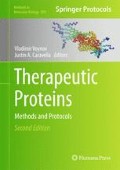Abstract
PEGylation of peptide and proteins is an important method of improving their pharmacokinetic, pharmacodynamic, and immunological profiles, and thus enhancing their therapeutic effect. However, PEGylation of peptides and proteins creates significant challenges for detailed structural characterization, such as PEG heterogeneity, site of PEG addition, and number of attached PEG moieties. Here, we present two methodologies for the structural characterization of PEGylated peptides and proteins. LC/MS methodology utilizing post-column addition of amines was developed to obtain accurate masses of PEGylated peptides and proteins, which can be used to assign the structures and number of attached PEGs. The PEGylated sites in PEGylated products could be elucidated with the tandem LC/MS methodology combining in-source fragmentation with CID-MS/MS. Both methodologies are applied to model PEGylated peptides to obtain the accurate masses and identify PEGylated sites.
Access this chapter
Tax calculation will be finalised at checkout
Purchases are for personal use only
References
Walsh G (2000) Biopharmaceutical benchmarks. Nat Biotechnol 18:831–833
Bruckdorfer T, Marder O, Albericio F (2004) From production of peptides in milligram amounts for research to multi-tons quantities for drugs of the future. Curr Pharm Biotechnol 5:29–43
Abuchowski A, McCoy JR, Palczuk NC, van Es T, Davis FF (1977) Effect of covalent attachment of polyethylene glycol on immunogenicity and circulating life of bovine liver catalase. J Biol Chem 252:3582–3586
Roberts MJ, Bentley MD, Harris JM (2002) Chemistry for peptide and protein PEGylation. Adv Drug Deliv Rev 54:459–476
Stigsnaes P, Frokjaer S, Bjerregaard S, van de Weert M, Peter Kingshott P, Moeller EH (2007) Characterisation and physical stability of PEGylated glucagon. Int J Pharm 330:89–98
Cunningham-Rundles C, Zhou Z, Griffith B, Keenan J (1992) Biological activities of polyethylene-glycol immunoglobulin conjugates resistance to enzymatic degradation. J Immunol Methods 152:177–190
Chapman AP (2002) PEGylated antibodies and antibody fragments for improved therapy: a review. Adv Drug Deliv Rev 54:531–545
Veronese FM, Mero A (2008) The impact of PEGylation on biological therapies. BioDrugs 22:315–329
Huang L, Gough PG, DeFelippis MR (2009) Characterization of poly(ethylene glycol) and PEGylated products by LC/MS with postcolumn addition of amines. Anal Chem 81:567–577
Lu X, Gough PG, DeFelippis MR, Huang L (2010) Elucidation of PEGylation site with a combined approach of in-source fragmentation and CID MS/MS. J Am Soc Mass Spectrom 21:810–818
Robinson EW, Garcia DE, Leib RD, Williams ER (2006) Enhanced mixture analysis of poly(ethylene glycol) using high-field asymmetric waveform ion mobility spectrometry combined with Fourier transform ion cyclotron resonance mass spectrometry. Anal Chem 78:2190–2198
Hanton SD (2001) Mass spectrometry of polymers and polymer surfaces. Chem Rev 101:527–569
Cooper AR (1989) Determination of molecular weight. In: Winefordner JD (ed) Chemical analysis, vol 103. Wiley, New York, p 526
Author information
Authors and Affiliations
Corresponding author
Editor information
Editors and Affiliations
Rights and permissions
Copyright information
© 2012 Springer Science+Business Media, LLC
About this protocol
Cite this protocol
Huang, L., Gough, P.C. (2012). Characterization of PEGylated Biopharmaceutical Products by LC/MS and LC/MS/MS. In: Voynov, V., Caravella, J. (eds) Therapeutic Proteins. Methods in Molecular Biology, vol 899. Humana Press, Totowa, NJ. https://doi.org/10.1007/978-1-61779-921-1_22
Download citation
DOI: https://doi.org/10.1007/978-1-61779-921-1_22
Published:
Publisher Name: Humana Press, Totowa, NJ
Print ISBN: 978-1-61779-920-4
Online ISBN: 978-1-61779-921-1
eBook Packages: Springer Protocols

